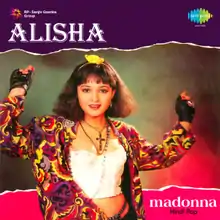Madonna (Alisha Chinai album)
Madonna is a 1989 Hindi-language platinum-selling pop album by Indipop star Alisha Chinai.[1]
| Madonna | ||||
|---|---|---|---|---|
 | ||||
| Studio album by | ||||
| Released | 1989 | |||
| Genre | Indipop | |||
| Length | 34:07 | |||
| Label | His Master's Voice | |||
| Producer | Rajesh Jhaveri | |||
| Alisha chronology | ||||
| ||||
The album is mainly Hindi-language covers of songs by the American singer Madonna, and the cover shows Alisha wearing provocative clothes similar to Madonna's at the period.[2][3] The album was promoted with a four city tour.[4] The Indian press reported that the American singer had actually acknowledged Alisha's tribute,[5] but a reaction came from Indian rapper Baba Sehgal who responded to Alisha's tour and album with a lampoon song "Madonna", where he also dressed as the American singer.[6]
Track listing
- "Dheere Dheere" / धीरे धीरे ("Material Girl")
- "Dekho Dekho" / देखो देखो ("Like a Virgin")
- "Papa" / पापा ("Papa Don't Preach")
- "Tere Bina" / तेरे बिना ("Live to Tell")
- "Pyaara Awaara" / प्यारा आवारा ("Dress You Up")
- "Aa Bhi Jaa" / आ भी जा ("La Isla Bonita")
- "Todo Na Mera Dil" / तोड़ो ना मेरा दिल ("Borderline")
- "Aake Chhoole" / आके छूले ("Lucky Star")
References
- Kasbekar, Asha (May 2006). "Pop Culture India!". Media, Arts, and Lifestyle: 34. OCLC 1851096361.
Alisha Chinai (1972– ) is the pioneer and undisputed Queen of Indipop—that's the verdict of the music industry. Her first major hit album was Jadoo (Magic). Further platinum albums included Aah Alisha, Baby Doll, Madonna, and Kamasutra, but it was Made in India that established Indipop as a discrete genre and Chinai its prime proponent
- John Connell, Chris Gibson Sound Tracks: Popular Music, Identity, and Place-- 2003 - Page 68 0415170273 "For example, the prominent north 1ndian singer, Alisha Chinai, successfully released a Madonna tape, with Hindi- language versions of Madonna's songs, and a cover depicting Alisha dressed in a gaudy bra and no shirt."
- Peter Manuel Cassette Culture: Popular Music and Technology in North India 0226504018 - 1993 "Some current hit cassettes — both film and nonfilm — borrow Western tunes, such as Alisha Chinai's Madonna tape, consisting of Hindi-language versions of her idol's songs, with a cover depicting Alisha dressed, appropriately, in a gaudy brassiere and no shirt."
- India Today Volume 14, Issues 5-8 - Page 202 1989 - "Alisha Chinai: material girl ♢ The belly button looks familiar. As do the clothes. And the sex-appeal. And the songs. And the voice? Well, not quite, but close enough for Alisha Chinai to pass off as India's answer to rock queen Madonna — and pack in the crowds at her just- concluded four-city singing tour. Chinai's Madonna imitations have already led to an album called, what else, Madonna, and the tour is to promote the record. Chinai's ambitions to recreate the Madonna magic do not ..
- The Illustrated Weekly of India 1989- Volume 110, Issues 40-53 - Page 39 "The traders of Punjab and the sharp minds of Gujarat, quick to sense opportunity, carved out the brand new domain of Hindi pop, dominated by the likes of 'Baby Doll' Alisha Chinai, who achieved the ultimate accolade of being acknowledged by Madonna herself as her most faithful imitation on earth."
- Gregory D. Booth, Bradley Shope More Than Bollywood: Studies in Indian Popular Music -- 2014 Page 174 0199928835 "Baba Sehgal as Madonna may seem even more improbable than his appropriation of “Ice Ice Baby.” However, Seghal does not imitate Vanilla Ice or Madonna so much as he uses their iconic images in a self-reflexive manner, in order to reinvent himself perhaps, but also to take playful jabs at the proclivity of Indian pop singers for the appropriation of the foreign. In this case, his primary target was Indipop superstar Alisha Chinai, who gained notoriety as “the Indian Madonna.” In fact ..."
This article is issued from Wikipedia. The text is licensed under Creative Commons - Attribution - Sharealike. Additional terms may apply for the media files.